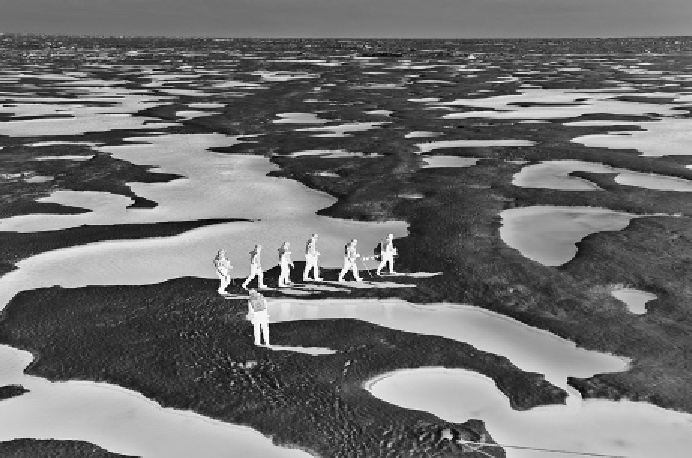Geoscience Reference
In-Depth Information
Figure 5.4.
Summer melt ponds on the sea ice surface (courtesy of Donald Perovich,
USA CRREL). (See plate section for color version.)
ice-covered parts of the Arctic Ocean. During the pre-melt (dry snow period), which
at the SHEBA site lasted until late May, the surface albedo decreased slightly, but
remained above 0.80. The albedo then dropped quickly during the initial period of
snowmelt and the initial formation of melt ponds on the sea ice surface. Relatively
dark melt ponds (
Figure 5.4
) further evolved from about the middle of June through
the first week of August. Although the albedo showed a further overall drop during
this period, to minimum values of 0.35-0.40, there were several periods in which
albedo temporarily increased, reflecting, in part, episodes of snowfall. Albedo then
increased again as melt ponds froze and new snowfall events whitened the surface.
5.4.5
Scale Issues
Surface albedo is a very scale-dependent variable. The numbers in
Table 5.3
and the
seasonal cycle shown in
Figure 5.2
refer to albedos that would be measured with
upward and downward facing pyranometers (instruments used to measure solar
radiation) from typically 1-10 m above the surface. The higher above the surface
the reflected component is measured, the greater is the areal integration of albedo.
Hence, some distinction should be made between local albedos and regional albe-
dos. The regional surface albedo α
r
can be expressed as:
α
r
= Σα
i
A
i
/ΣA
i
(5.5)
where α
1
is the albedo of the different surfaces (i) over a region and A
i
is the area
covered by each surface. Developing appropriate parameterizations of regional

